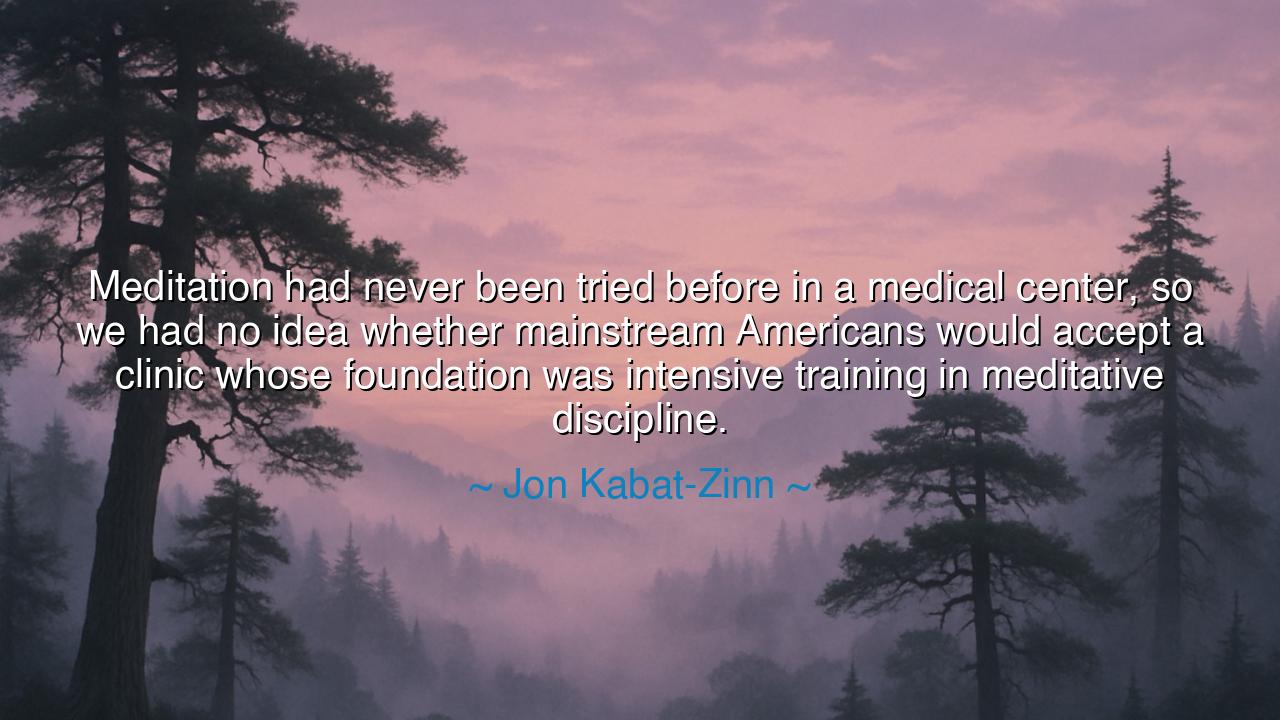
Meditation had never been tried before in a medical center, so we
Meditation had never been tried before in a medical center, so we had no idea whether mainstream Americans would accept a clinic whose foundation was intensive training in meditative discipline.






When Jon Kabat-Zinn reflected, “Meditation had never been tried before in a medical center, so we had no idea whether mainstream Americans would accept a clinic whose foundation was intensive training in meditative discipline,” he was not only recalling the birth of an experiment, but speaking to the eternal tension between ancient wisdom and modern skepticism. His words remind us of a time when practices of the spirit were still strangers in the halls of science, and when the idea that healing could arise not only from drugs and knives, but from the stillness of the mind, seemed daring — even impossible.
The meaning of his statement lies in the courage to bring the inner disciplines of the East into the sterile, clinical world of the West. In a time when medical centers were governed almost entirely by the scalpel, the pill, and the machine, Kabat-Zinn dared to suggest that meditation, long practiced in temples and monasteries, could stand alongside these as a source of healing. His words carry both humility and defiance: humility in admitting the uncertainty of acceptance, defiance in daring to walk the uncharted path.
The origin of this truth lies in the crossing of civilizations. For centuries, monks and sages of India, China, and Tibet had practiced meditation as a way to master the mind and calm the storm of human suffering. Yet their wisdom remained cloaked in mysticism to much of the West. Kabat-Zinn’s vision was to translate this ancient practice into the language of science, to bring the silence of the temple into the corridors of the medical center, not as religion, but as discipline, not as faith alone, but as measurable practice.
History offers us similar moments of daring fusion. Consider the physicians of Alexandria in antiquity, who blended Greek science with Egyptian wisdom to create medicine that endured for centuries. Or recall the Renaissance, when scholars dared to reintroduce ancient Greek and Arabic texts into Europe, and by doing so, laid the foundation for modern science. Kabat-Zinn stood in this tradition: a bridge-builder who risked mockery in order to show that truth can dwell in both the laboratory and the monastery.
The significance of this venture becomes clearer when we recall the suffering it sought to address. Chronic pain, stress, anxiety — conditions for which medicine often had little cure — found a new response in mindfulness. Patients who once relied only on pills discovered that through meditative discipline, they could gain mastery over their pain and their fears. What once seemed strange became lifesaving, and what once was dismissed as mysticism became recognized as medicine. Kabat-Zinn’s uncertainty — would Americans accept this? — gave way to a revolution in healing.
The lesson for us is powerful: innovation often requires the courage to carry wisdom from the margins into the center. What seems unthinkable today may become indispensable tomorrow. Just as Kabat-Zinn dared to offer meditation to the halls of medicine, so too must we dare to bring compassion, stillness, and new ways of seeing into the places where they are most resisted. For the world does not advance by comfort, but by vision.
Practical actions follow. In our own lives, we can honor this wisdom by practicing meditation ourselves — not as ritual alone, but as discipline, a training of the mind to meet life’s storms with calm. We can support the blending of ancient wisdom with modern science, recognizing that truth is not bound to time or culture. And we can learn to look upon new ideas with openness rather than suspicion, remembering that every great transformation begins as an experiment.
Thus, Jon Kabat-Zinn’s words remind us that the greatest revolutions are sometimes born in silence. What was once a daring experiment in a medical center has now become a movement embraced across the world. May we take his story as both inspiration and charge: to bring together the wisdom of the past with the tools of the present, and to walk unafraid into the untried paths that may one day heal the future.






AAdministratorAdministrator
Welcome, honored guests. Please leave a comment, we will respond soon